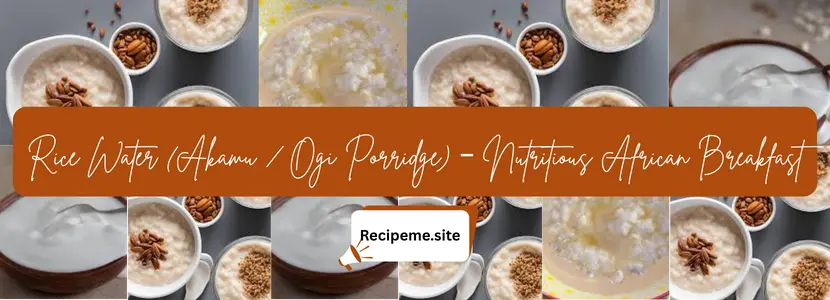
Introduction
What’s the one dish that reminds you of childhood mornings—warm, soothing, and filled with comfort? For many families across West Africa, the answer is simple: Rice Water, also known as Akamu or Ogi Porridge.This creamy porridge, made from fermented grains, is more than just breakfast—it’s a symbol of nourishment, care, and tradition. Growing up, the aroma of freshly cooked Ogi filled kitchens on chilly mornings, often paired with akara (bean cakes) or moin-moin. It was the go-to meal when children were sick, when mothers wanted something light yet filling for the family, or simply when a warm start to the day was needed.
But beyond being a humble porridge, Rice Water carries centuries of tradition, cultural meaning, and surprising nutritional benefits.
History of Rice Water (Akamu / Ogi Porridge)
Ogi, also called Akamu in Igbo and Pap in Yoruba, has roots tracing back to centuries-old West African culinary traditions. Traditionally made from fermented maize, sorghum, or millet, it was a staple for breakfast and weaning infants.
The Rice Water version became popular as rice farming spread across Africa. Rice, being naturally soft and digestible, made the porridge lighter and gentler on the stomach. Over time, families began preparing rice water alongside the traditional corn-based Akamu, especially for children and elders who needed easily digestible meals.
Did You Know? In many Nigerian households, Rice Water was historically considered a “healing food,” often given to recovering patients and breastfeeding mothers for strength.
Essential Ingredients
Preparing Rice Water (Ogi Porridge) requires just a few basic ingredients, yet the result is rich in flavor and nutrition.
Core Ingredients:
-
Rice (white or parboiled, sometimes blended into a smooth paste)
-
Water
-
Sugar or honey (optional, for sweetness)
-
Evaporated or powdered milk (optional)
Accompaniments (Traditional Pairings):
-
Akara (fried bean cakes)
-
Moin-Moin (steamed bean pudding)
-
Fried plantains
-
Bread and butter
Variations of Rice Water
One of the beautiful aspects of Ogi is its adaptability. Across West Africa, different communities prepare Rice Water with their own twists:
-
Plain Rice Water: Cooked rice blended with water, boiled into a smooth porridge.
-
Rice + Maize Ogi Mix: A blend of rice and corn paste for a richer, more traditional taste.
-
Sweetened Ogi: With added honey, sugar, or flavored syrups for children.
-
Spiced Rice Water: Infused with nutmeg, cloves, or ginger for warmth and depth of flavor.
-
Nutritious Fortified Ogi: Enriched with groundnuts, soya, or milk for added protein.
Preparation: Step-by-Step Guide
Here’s a simple method to prepare delicious Rice Water at home:
Ingredients for 3–4 Servings:
-
1 cup rice
-
4 cups water
-
1 cup milk (optional)
-
Sugar or honey (to taste)
Instructions:
-
Wash and Boil Rice
-
Rinse rice thoroughly and place in a pot with water. Boil until very soft.
-
-
Blend or Mash
-
Once cooked, blend the rice with some of the cooking water until smooth. (Traditionally, a wooden spoon was used to mash it.)
-
-
Return to Heat
-
Pour the blended rice mixture back into the pot. Stir continuously on low heat to avoid lumps.
-
-
Sweeten and Enrich
-
Add sugar, honey, or milk according to preference. Stir until creamy.
-
-
Serve Hot
-
Pour into bowls and pair with akara, moin-moin, or bread.
-
Pro Tip: Continuous stirring is key—this prevents lumps and ensures a silky, smooth porridge.
Cultural Significance
Rice Water is more than food; it’s woven into African traditions:
-
Breakfast Staple: Served in households daily, especially for schoolchildren.
-
Ceremonial Use: Offered during traditional gatherings or communal events.
-
Weaning Food: Given to babies transitioning from breast milk due to its softness and digestibility.
-
Healing Meal: Often recommended for the sick and elderly as a light but nourishing dish.
In many Nigerian and Ghanaian homes, Rice Water is a reminder of care and hospitality—offered to guests as a gesture of warmth.
Serving Suggestions
Rice Water can be enjoyed in several creative ways:
-
With akara for a protein-packed breakfast.
-
With moin-moin for a balanced meal.
-
With fried plantains for sweetness.
-
With bread and butter for a quick, filling option.
-
As a light dinner with added milk for children.
Did You Know? Some modern cafés in Lagos now serve Rice Water with toppings like granola, fruits, or nuts—blending tradition with modern health trends.
Types of Ogi / Akamu Porridge
While Rice Water is a popular variant, Ogi has other traditional forms worth noting:
-
Corn Ogi (Akamu): The most common, made from fermented maize.
-
Millet Ogi: Common in Northern Nigeria, with a nutty flavor.
-
Sorghum Ogi: Richer in iron, often served to lactating mothers.
-
Rice Ogi (Rice Water): Lighter and gentler, ideal for children.
Tips for Making Perfect Rice Water
-
Always cook the rice until very soft—undercooked rice won’t blend smoothly.
-
Stir continuously to avoid lumps.
-
Use a blender for creaminess, but a wooden spoon can give a rustic, traditional texture.
-
Don’t overload with sugar—natural sweetness from milk or honey is better.
-
Serve hot; Rice Water tends to thicken as it cools.
Other Valuable Information
-
Nutritional Value: Rice Water is rich in carbohydrates for energy, and when paired with milk or beans, becomes a balanced meal.
-
Hidden Fact: Traditional healers once recommended Ogi for stomach ailments because of its soothing texture.
-
Expert Insight: Nutritionists often suggest fortifying Rice Water with soy or groundnuts to improve protein content for children.
Personal Experience: A Journey with Rice Water
I remember my grandmother’s kitchen in Lagos—every Saturday morning, she prepared a steaming pot of Rice Water. The rich aroma of boiling rice filled the air, and as children, we eagerly waited for the smooth porridge served with akara fresh from the frying pan.
It wasn’t just food; it was tradition. It was the taste of care, of family, of mornings filled with love. Today, even when I prepare it in my own home, I feel connected to that same warmth and heritage.
Conclusion
Rice Water (Akamu / Ogi Porridge) is far more than a simple breakfast—it’s history, culture, nourishment, and comfort in a bowl. Whether enjoyed plain, fortified with milk, or paired with akara, it continues to be a symbol of African resilience and tradition.
So, the next time you’re craving something warm, wholesome, and nostalgic, why not prepare a pot of Rice Water and experience the magic yourself?
Frequently Asked Questions (FAQs)
1. What is Rice Water (Ogi) made from?
Rice Water is made from boiled and blended rice cooked into a smooth porridge, sometimes enriched with milk or sweeteners.
2. Is Rice Water the same as Akamu or Ogi?
Yes, Ogi is the general name for fermented grain porridge. While traditional Ogi is from maize, millet, or sorghum, Rice Water is the rice-based variation.
3. Is Rice Water healthy?
Yes, it provides energy and is easy to digest. When paired with protein-rich foods like akara or milk, it becomes a balanced meal.
4. Can babies eat Rice Water?
Absolutely! Rice Water is commonly used as weaning food because it is light, smooth, and easy for infants to digest.
5. How long does Rice Water last?
It’s best consumed fresh, but refrigerated Rice Water can last up to 2 days. Reheat with a little water before serving.
6. Can Rice Water be flavored?
Yes, spices like nutmeg, ginger, or cinnamon can be added for warmth and flavor. Some people even add fruits for a modern twist.
